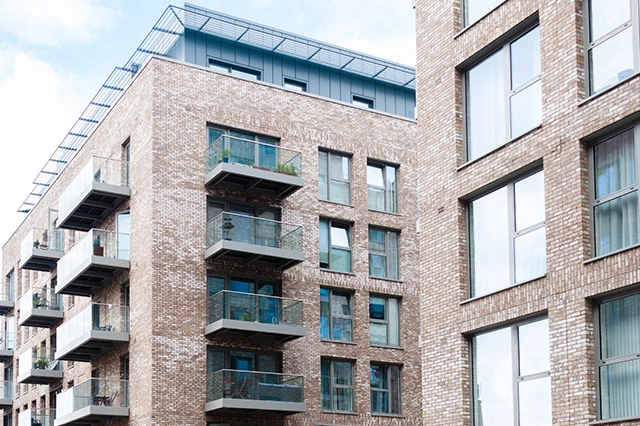Insuring a block of flats isn’t just “buildings insurance x however-many units.” It’s a specialist class of cover that needs careful attention to valuation, legal duties, building safety, leases, and day-to-day realities like leaks, lifts and short-term lets. This guide walks you through what to consider, what people often overlook, what insurers look for, and what happens (and what you’ll need) if there’s a claim.
Who typically arranges cover (and how policies are structured)
Freeholder / Landlord – often responsible under the lease to arrange the buildings policy and recharge via the service charge.
Residents’ Management Company (RMC) / Right to Manage (RTM) company – common where leaseholders control management; they usually place the policy.
Managing Agent – may place cover on the client’s behalf but should ensure correct insured parties are listed (e.g., freeholder, RMC/RTM, managing agent “for their respective rights and interests”).
Named/Interested Parties – lenders, leaseholders, and managing agents often need noting. Ask for composite insured or non-invalidation/waiver wording where appropriate, so one party’s act doesn’t prejudice another’s cover.
Tip: Always check the lease. It will dictate who must insure, the required perils/limits, and how premium is recovered.
Core covers you’ll need
Buildings (reinstatement) insurance – the fabric of the building: structure, roof, communal parts.
Property Owners’ Liability – protection if a third party is injured or property is damaged (e.g., falling masonry). Common limits £5m–£10m.
Loss of Rent / Alternative Accommodation – pays lost ground rent/service charge income (or leaseholder rent) and rehousing costs following an insured event. Choose an indemnity period of 24–36 months for major losses.
Terrorism – often a lender/lease requirement in cities; typically provided via Pool Re in the UK.
Communal Contents – carpets, furniture, gym equipment, art in lobbies, gardening tools.
Directors & Officers (D&O) – for RMC/RTM directors’ personal liability.
Engineering Inspection & Breakdown – statutory inspections (e.g., lifts, boilers/pressure systems) and cover for sudden mechanical/electrical breakdown.
Legal Expenses – disputes, eviction/legal defence (scope varies).
Fidelity/Crime – protection against employee/agent dishonesty where funds are handled.
Getting the sum insured right (and avoiding underinsurance)
The most expensive mistake in block insurance is underinsurance. Policies apply Average: if you’re 25% under-declared, you could only be paid 75% of a loss.
What to do:
Base the Declared Value on a professional reinstatement cost assessment (RICS is the standard) that includes:
- Demolition and debris removal
- Professional fees (architects, engineers)
- External works (car parks, walls, gates, landscaping)
- Communal areas and fixed services (lifts, plant, PV panels)
- Compliance upgrades during rebuild (e.g., current building regs)
Use Day One uplift (often +15–50%) and index-linking to mitigate inflation risk between valuation and loss.
Refresh formal valuations every 3–5 years (or sooner after major works).
Risk features & rating factors insurers scrutinise
Construction & Fire Safety
- Year built, height, method (traditional masonry vs. timber frame vs. modular).
- External wall systems (cladding), balcony materials, and cavity barriers.
- Fire strategy (compartmentation, detection, sprinklers), protected escape routes.
- Fire Risk Assessment quality and actions completed; fire door checks and records.
Water & Services
- Age/condition of plumbing, heating and roof coverings (flat roof percentage and material).
- History of escape of water claims; presence of leak detection/shut-off valves.
- Condition of soil stacks, risers, and wet rooms.
Location Perils
- Flood history and defences; distance to rivers/sea; surface water risk.
- Subsidence/heave/landslip history; local soil type; proximity/management of trees.
Security & Occupancy
- Controlled entry/CCTV, lighting, bike stores, parcel rooms.
- Resident profile: owner-occupied vs. ASTs vs. short-term lets (e.g., Airbnb).
- Unoccupied units or significant commercial use in mixed-use blocks.
Management & Compliance
- Evidence of planned maintenance (roof, gutters, M&E).
- Records: FRA, EICR (electrical), emergency lighting, alarm servicing, lift inspections.
- Claims history quality and learning actions taken.
Common gaps and things people forget
- Loss of Rent/Alt Accommodation period too short. Major fires or structural events often exceed 12–18 months; 24–36 months is safer.
- Trace & Access limits too low for modern plumbing stacks. Increase limits and consider leak detection for higher floors.
- Communal contents under-declared (lobbies, gyms, playrooms, concierge equipment).
- Outbuildings/external property—bin stores, bike shelters, railings, gates, charging points, solar/PV arrays, EV chargers, CCTV and access control.
- Underground services—cables, pipes, drains to the public main (and trace, excavation, and reinstatement).
- Terrorism omitted (especially outside central business districts) despite lender/lease obligations.
- Engineering inspections—legal requirement for lifts and certain pressure systems; not the same as maintenance.
- D&O cover for RMC/RTM directors—often assumed to be included in buildings (it isn’t).
- Non-standard occupancy—short-term lets or holiday use not disclosed.
- Cladding/balcony materials details not kept up to date with the insurer (especially after remediation).
- Minimum standards/warranties not followed (heating left on or systems drained in winter, leak detection use, lock specifications, weekly unoccupied checks, etc.).
Legal & regulatory duties to keep in mind (plain-English overview)
- Duty of Fair Presentation (Insurance Act 2015): disclose every material circumstance you know (or ought to know)—including construction, occupancy, history, and risk improvements—or enough to put an insurer on notice to ask more.
- Fire Safety regime: responsible persons must have a suitable and sufficient Fire Risk Assessment and maintain records and fire safety measures, with extra duties for higher-risk/residential buildings. Keep test/maintenance logs for alarms, emergency lighting, fire doors, etc.
- Statutory inspections: lifts and certain pressure systems require periodic examination by a competent person (separate from routine maintenance).
- Health & safety in common parts: manage slip/trip hazards, lighting, glazing, balcony safety, etc.
(This is a summary, not legal advice—work with your landlord insurance broker and competent professionals for your building’s specifics.)
Policy design choices that improve outcomes
- Higher escape-of-water excess + leak mitigation (auto-shut-offs, monitoring) can reduce premium and claims frequency.
- Subsidence excess set realistically; invest in tree management and drainage surveys in high-risk areas.
- Non-invalidation / waiver of subrogation language to protect leaseholders and managing agents when one party breaches a condition.
- Average waiver or Rebuild Cost Assessment guarantee where available (still keep valuations current).
- Claims preparation costs or loss assessor fees extensions for large/complex losses.
- Alternative accommodation—including pets and vulnerable residents—ensure wording fits the building’s reality.
- Contract works overlap if major refurbishments occur; coordinate with contractors’ insurance and consider Non-Negligent Liability (6.5.1) where applicable.
What an insurer will want to see (before quoting and at renewal)
Data & Documents
- Full address, number of units, storeys, and any commercial parts.
- Construction details (walls/roof), year built, refurb dates, % flat roof, listed status.
- External wall/balcony materials and any remediation status.
- Reinstatement Declared Value and basis (date and source of valuation), Day One uplift.
- Security features and building services (sprinklers, detection, access control, CCTV).
- Occupancy mix (owner-occupied, ASTs, short-term lets), unoccupied units.
- Claims history (at least five years), including causes and improvements implemented.
- Risk surveys, FRA, EICR, lift inspection reports, maintenance schedules.
- Flood/subsidence history and nearby trees/ground conditions.
- Management: who manages, out-of-hours response, contractors, permits to work.
Site Standards
- Good housekeeping (plant rooms clear, bins external and away from façade, no combustibles in risers).
- Evident maintenance culture (gutter clearing, roof inspections, leak fixes, testing regimes).
What’s required in the event of a claim
Immediate actions
- Protect life and property. Call emergency services if needed.
- Mitigate loss. Stop leaks (isolate water), board up, make safe (don’t delay emergency repairs).
- Notify your broker/insurer promptly with policy number, date/time, and what happened.
Information to provide
- Photos/video and a simple incident timeline.
- Contact details for on-site lead (concierge/agent) and access arrangements.
- For theft/criminal damage: crime reference number.
- For water damage: evidence of the source (plumber’s report), actions taken, and Trace & Access invoices.
- For subsidence/structural: any prior movement history, drainage CCTV, tree surveys.
- For fire: FRA, alarm logs, maintenance records, fire door inspection records.
Estimates & contractors
- Obtain detailed, like-for-like repair estimates (often two). The insurer may appoint a loss adjuster and surveyor. For large/complex losses you may engage a loss assessor (your representative).
- Expect scope validation: the adjuster will compare contractor scopes to reinstatement needs, standards and policy cover.
Settlement mechanics
- Reinstatement basis: typically pay actual repair/rebuild costs (net of VAT if you can recover it).
- Cash settlement may be offered; ensure it covers full reinstatement including fees and prelims.
- Underinsurance/Average: if your sum insured is too low, the payout is reduced proportionately.
- Loss of Rent/Alt Accommodation: paid during the indemnity period you selected; keep clear records of tenancy/charge schedules.
Communication & records
- Keep a claim diary, including decisions and approvals.
- Log all health & safety measures taken post-incident (e.g., drying regimes, mould prevention, temporary fire watch).
- For multi-party buildings, send regular factual updates to leaseholders; align with the lease and managing agent’s communication policy.
Practical annual checklist
- Rebuild valuation: confirm date; plan a new RICS assessment every 3–5 years or after major works.
- Indemnity period for Loss of Rent/Alt Accommodation: 24–36 months.
- Risk assessments & inspections: FRA, EICR, lifts/pressure systems; action the findings.
- Water risk: leak detection in risers/plant; winterisation plan; review EoW excess/controls.
- External wall/balcony status: keep insurer updated on materials and remediation progress.
- Sums insured include external areas, gates/railings, EV chargers, PV panels, underground services.
- Policy conditions/warranties understood and embedded into site procedures (unoccupied flat checks, minimum security, plant maintenance).
- Named/Interested Parties and correct insured entity per the lease.
- Claims review: trends, root causes, and fixes.
- Broker meeting: go through survey recommendations, cover improvements, and market competitiveness.
Working with the right partners
A specialist block of flats insurance broker who regularly places UK blocks is invaluable. They’ll:
- interpret lease obligations,
- arrange accurate valuations,
- position the risk to underwriters (with strong risk-management evidence), and
- coordinate claims efficiently with adjusters and contractors.
Bottom line
The best block-of-flats insurance programme is built on three pillars:
- Accurate sums insured and realistic indemnity periods;
- Robust compliance and maintenance evidence (fire, electrical, lifts, water); and
- Clear disclosure under the duty of fair presentation.
Get those right, and premiums are more defensible, cover responds as intended, and claims run smoother when you need them most.
If you want, I can turn this into a one-page checklist you can share with your board/leaseholders—or tailor it to your specific building (height, age, cladding status, occupancy mix).







